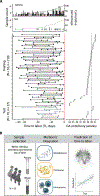Integrated trajectories of the maternal metabolome, proteome, and immunome predict labor onset
- PMID: 33952678
- PMCID: PMC8136601
- DOI: 10.1126/scitranslmed.abd9898
Integrated trajectories of the maternal metabolome, proteome, and immunome predict labor onset
Abstract
Estimating the time of delivery is of high clinical importance because pre- and postterm deviations are associated with complications for the mother and her offspring. However, current estimations are inaccurate. As pregnancy progresses toward labor, major transitions occur in fetomaternal immune, metabolic, and endocrine systems that culminate in birth. The comprehensive characterization of maternal biology that precedes labor is key to understanding these physiological transitions and identifying predictive biomarkers of delivery. Here, a longitudinal study was conducted in 63 women who went into labor spontaneously. More than 7000 plasma analytes and peripheral immune cell responses were analyzed using untargeted mass spectrometry, aptamer-based proteomic technology, and single-cell mass cytometry in serial blood samples collected during the last 100 days of pregnancy. The high-dimensional dataset was integrated into a multiomic model that predicted the time to spontaneous labor [R = 0.85, 95% confidence interval (CI) [0.79 to 0.89], P = 1.2 × 10-40, N = 53, training set; R = 0.81, 95% CI [0.61 to 0.91], P = 3.9 × 10-7, N = 10, independent test set]. Coordinated alterations in maternal metabolome, proteome, and immunome marked a molecular shift from pregnancy maintenance to prelabor biology 2 to 4 weeks before delivery. A surge in steroid hormone metabolites and interleukin-1 receptor type 4 that preceded labor coincided with a switch from immune activation to regulation of inflammatory responses. Our study lays the groundwork for developing blood-based methods for predicting the day of labor, anchored in mechanisms shared in preterm and term pregnancies.
Copyright © 2021 The Authors, some rights reserved; exclusive licensee American Association for the Advancement of Science. No claim to original U.S. Government Works.
Conflict of interest statement
Figures





References
-
- Suff N, Story L, Shennan A, The prediction of preterm delivery: What is new? Semin. Fetal Neonatal Med 24, 27–32 (2019). - PubMed
-
- Hutcheon J, Lee L, Marquette G, 320: Predicting the onset of spontaneous labour (OSL) in post date pregnancies. Am. J. Obstet. Gynecol 208, S143–S144 (2013).
Publication types
MeSH terms
Substances
Associated data
Grants and funding
LinkOut - more resources
Full Text Sources
Other Literature Sources
Medical
Research Materials

